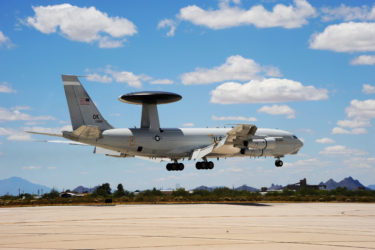Cay Vandervelde gives her insights about the globally-focused and flexible Master of Infrastructure Planning and Management (MIPM) program

Cay currently lives in the Netherlands where she works for NATO’s AWACS Program Management Agency. She approaches her work with dedication and care, stating that “I know all it takes is hard, attentive work to get there.” Once Cay began her coursework at the University of Washington, she received an offer to work for the NATO organization that had once been her customer at Boeing supporting the next modernization of the NATO AWACS. When reflecting on the program, Cay states that, “In my mind, I combine the technical and process instruction I am receiving from the MIPM Program with my increasing awareness of the real needs of people, and I see that my personal education and activism is where the most good can be fostered.” This globally focused program is not only educating highly qualified and experienced professionals but is creating better citizens of the world.
Before she joined her MIPM cohort, Cay worked as a Systems Engineer and leader of the Integrated Product Team for Boeing Defense Systems for nearly 30 years. She supported Boeing’s Airborne Warning and Control System (AWACS) E-3A and its derivative, the NATO AWACS NE-3A. The AWACS is an airborne radar system designed to detect aircraft, ships, and vehicles from long a range so that strategic decisions can be made about engaging fighter and attack aircraft strikes. Her career with Boeing came to an unexpected end once the company made a business decision to move the AWACS programs (including engineering) to its Oklahoma City location near Tinker Air Force Base in 2015. The decision resulted in a number of transfers and layoffs, which left Cay looking for new opportunities beyond her current industry. “As an employee with almost 30 years at Boeing… I wasn’t sure how directly transferable my skills would be to a new career.” In searching for a new source of employment, Cay answered several advertisements ranging from managerial positions at Starbucks to local programs within the US Navy.

The Trade Adjustment Assistance program, operated by the Employment Security Department (ESD), is designed to help Washington State residents who have been laid off by providing training that will make them more employable. As part of the process, the candidate has to select a career path that the ESD determines is in demand in the state of Washington, interview potential employers to ensure that the occupations will be a good fit and show that they are capable of supporting themselves through the program. Fortunately, urban planning was on the list of in-demand careers and gave Cay the second chance she had been looking for.
Q: What is your current role and your responsibilities with NATO?
I’m a risk manager for the NATO Airborne Early Warning & Control Programme Management Agency (NAPMA). The purpose of the position was originally to address business and financial risks of interest to the COSO Framework. But COSO has since enlarged its scope of interest to the full set of risks that threaten the enterprise level of an organization, including technical risks. NAPMA hasn’t had a risk manager before, so it’s clear blue sky as far as how I proceed with establishing a repeatable, value-added and documented set of practices and processes.
I find my background from the Boeing Company, working on NATO AWACS contracts, prepared me well for technical and project management-type risks and the applicable risk management tools and processes. But the business, enterprise and financial aspects of running this agency are new for me – I’m on something of a learning curve, content-wise, in those areas. Being a little smart in all these areas will help me be able to guide calibrating them in terms of prioritized risk assessment, evaluation and mitigation planning.
Q: Do the skills you’ve learned in the MIPM program help in your new role?
I absolutely apply the skills I developed in the MIPM curriculum, and not just in the risk management area, which is a particular point of emphasis for infrastructure management and is addressed from a wide range of perspectives in most of the coursework and texts. I have brought my books and electronic references with me to the job and consult them often, making sure that I am not lured into tailoring the NAPMA risk management program into something shaped by the immediate hopes and fears of the current set of stakeholders, but that I keep an eye to the horizon of long-term value and receptivity to changing contexts. This is a major theme throughout the IPM profession, as I am coming to understand more and more.
All the instruction in the IPM program on strategic and systems thinking is completely applicable to my job, and I have tried out a number of the models we’ve studied in bounding and communicating the scope of our agency risk interests. Since I’m only about halfway through the MIPM curriculum, I fully expect to have many more “a-ha” moments with every new quarter, and be able to improve my contributions to NAPMA organizational integration and goals even more.
Q: What attracted you to the Master of Infrastructure Planning and Management degree?
There were two or three Urban Planning programs I considered, but the MIPM program at the University of Washington was my preferred choice from the beginning. I looked at the faculty and their involvement in organizations and programs outside the University itself. I looked at the curriculum, full of topics in which I already had a healthy citizen’s interest, and it had the remarkable advantage of being an on-line program! A tremendous convenience for someone with a long commute from the school and who was also looking for work ‘on the side’ to keep the mortgage paid. The main thing during that period of rapid-fire transition in my life, was that the MIPM office was exceptionally helpful in providing an expedited review of my application and guiding me through the matriculation process at the very last minute, before the first day of the Fall Quarter. Without that, I’d probably still be dithering about what to do and where to go.
Is a return to school daunting? Well, yes and no. Yes, in that this program has forced me outside my comfort zone professionally. I’d found a home in the aerospace industry, system engineering modifications to an aging military aircraft, and now I have to pay close attention to the details of using modern Geographic Information Systems (GIS) or Epidemiology terms of reference. These details are important and need to be learned so I don’t have the luxury of being able to only concentrate on the big picture. Because of the newness of the specific material, getting my homework done and in on time is as daunting as it ever was. But no, not so daunting. What I know is that this subject matter is not only interesting but important; and with a somewhat practiced view to the big picture, the details fall right into place for me. I think I might have an advantage now, as opposed to 30 years ago, in that I can see the horizon, and I know all it takes is hard, attentive work to get there. Not more, not less.
Q: What tips/wisdom can you pass along to others considering retooling their skills and knowledge to stay current in our rapidly changing job markets?
Life is full of circles within circles. Once I’d started my coursework at UW in the MIPM program, I received a query about my willingness to come work for the NATO organization that had been my customer at Boeing to support the next big modernization program for the NATO AWACS. It took all of 3 seconds to say “YES!” I have always admired NATO, a consensus-run political decision-making body that has managed to acquire, maintain, and deploy its internationally-owned NE-3A fleet for almost 50 years. Being one of its preferred contractors was not the same as the unbelievable opportunity to witness its workings from the inside and do some good for my favorite airplane! Naturally, I wondered if I could keep up with the MIPM program while stationed abroad, but its on-line design, carefully and beautifully executed by each instructor and TA I’ve had so far, has made keeping the program up as ‘easy’ as it can possibly be. A major thing I have in my favor is the time difference – 9 hours ahead. Although for me it’s the same kind of week that any working student has, I am always working 9 hours before everyone else, and usually seem to submit my assignments well in advance of the deadline. As long as I can stay disciplined, I hope my teachers will always see me as on top of my work.
Q: Does the design of the program support a student’s ability to complete assignments from anywhere in the world with internet connectivity?
Yes, the design of the on-line program is perfect for the international student or working professional. In my own experience, the instructors have made written and lecture materials, including videos, available in an extremely effective way. Every one of them has been readily available and completely responsive via email, Skype or otherwise in the way of “office hours.” Some are not even local to the UW in Seattle or are sometimes on business travel themselves. In fact, my TA for the Epidemiology class is in Kenya right now, letting us know she’d be inaccessible for a half a day while she traveled there!
A rough spot is associated with team assignments, which most teachers make optional. The time differences can be a problem there because my fellow students are also holding down a day-job and in many cases have families to attend to, so I usually elect to work on my own. I’m sad about that, because my first Quarter when I was in the Seattle area, I really enjoyed getting to know my fellow student-teammates.
Q: How has your view of infrastructure changed during the course of the MIPM program?
They have changed regarding the integrated nature of the policies and problems that must be addressed for a functioning built environment. The meta-issues of infrastructure security and climate change, and the “knock-on” effect of one failure as it contributes to follow-on failures is boggling. It reminds me of when I took up bee-keeping. Soon you’re not just taking care of little insects in a hive, you’re looking at the weather every day (the temperature, the wind, the precipitation), and you’re tracking the nectar flow in the foliage, or watching the vigor of the plants in your garden, or your neighbors’ gardens and eventually everything seems connected to everything else – including your own self, as the bee-keeper in service to the hive!
To learn more about the MIPM program, please visit infrastructure-management.uw.edu.